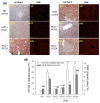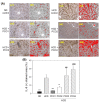Cuban Policosanol (Raydel®) Potently Protects the Liver, Ovary, and Testis with an Improvement in Dyslipidemia in Hyperlipidemic Zebrafish: A Comparative Study with Three Chinese Policosanols
- PMID: 37764386
- PMCID: PMC10534397
- DOI: 10.3390/molecules28186609
Cuban Policosanol (Raydel®) Potently Protects the Liver, Ovary, and Testis with an Improvement in Dyslipidemia in Hyperlipidemic Zebrafish: A Comparative Study with Three Chinese Policosanols
Abstract
Many policosanols from different sources, such as sugar cane and rice bran, have been marketed worldwide to improve blood lipid profiles. But so far, no comparative study has commenced elucidating the effect of different policosanols to improve the blood lipid profile and other beneficial effects. This study compared the efficacy of four different policosanols, including one sugar cane wax alcohol from Cuba (Raydel®) and three policosanols from China (Xi'an Natural sugar cane, Xi'an Realin sugar cane, and Shaanxi rice bran), to treat dyslipidemia in hyperlipidemic zebrafish. After 12 weeks of consumption of each policosanol (final 0.1% in diet, wt/wt) and a high-cholesterol diet (HCD, final 4%, wt/wt), the Raydel policosanol group and the Xi'an Natural policosanol group showed the highest survivability, of approximately 81%. In contrast, the Xi'an Realin policosanol and the Shaanxi policosanol groups showed 57% and 67% survivability, respectively. Among the five HCD groups, the Raydel policosanol group showed the lowest serum total cholesterol (TC, p < 0.001 versus HCD control) and triglyceride (p < 0.001 versus HCD control), with the highest percentage of high-density lipoproteins-cholesterol in TC. The Raydel policosanol group also showed the lowest serum aspartate aminotransferase and alanine aminotransferase levels, with the least infiltration of inflammatory cells and interleukin-6 production in hepatocytes with a marked reduction in reactive oxygen species (ROS) production and fatty liver changes. In the ovary, the Raydel policosanol group also showed the highest content of mature vitellogenic oocytes with the lowest production of reactive oxygen species and cellular apoptosis in ovarian cells. In the testes, the Raydel policosanol group also showed the healthiest morphology for spermatogenesis, with the lowest interstitial area and reactive oxygen species production in testicular cells. Conclusively, among the tested policosanols, Cuba (Raydel®) policosanol exhibited a comparatively better effect in maintaining zebrafish body weight, survivability, blood lipid profile, hepatic function biomarkers, fatty liver changes, ROS generation, inflammation, and restoration of the cell morphology in ovaries and testes affected by the HCD consumption.
Keywords: apoA-I; high-cholesterol diet; high-density lipoproteins; inflammation; interleukin-6; liver; ovary; policosanol; testis.
Conflict of interest statement
The authors declare no conflict of interest.
Figures










References
MeSH terms
Substances
LinkOut - more resources
Full Text Sources

